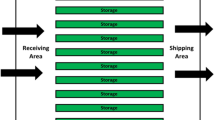Abstract
We address the sequencing of requests in an automated storage/retrieval system with dedicated storage. We consider the block sequencing approach, where a set of storage and retrieval requests is given beforehand and no new requests come in during operation. The objective for this static problem is to find a route of minimal total travel time in which all storage and retrieval requests may be performed. The problem of sequencing a list of retrievals is equivalent to the Traveling Salesman Problem (TSP), and thus NP-hard in general. We show that the special case of sequencing under the dedicated storage policy can be solved in polynomial time. The results apply to systems with arbitrary positions of the input and output stations. This generalizes the models in the literature, where only combined input/output stations are considered. Furthermore we identify a single command area in the rack. At the end we evaluate the model against heuristic procedures.
Similar content being viewed by others
References
Hausman, W.H., Schwarz, L.B. and Graves, S.C. (1976) Optimal storage assignment in automatic warehousing systems. Management Science, 22 (6), 629–638.
Heskett, J.L. (1963) Cube-per-order index – a key to warehouse stock location. Transportation and Distribution Management, 3, 27–31.
Graves, S.C., Hausman, W.H. and Schwarz, L.B. (1977) Storage-retrieval interleaving in automatic warehousing systems. Management Science, 23 (9), 935–945.
Hwang, H. and Lim, J.M. (1993) Deriving an optimal dwell point of the storage/retrieval machine in an automated storage/retrieval system. International Journal of Production Research, 31 (11), 2591–2602.
Han, M.-H., McGinnis, L.F., Shieh, J.S. and White, J.A. (1987) On sequencing retrievals in an automated storage/retrieval system. IIE Transactions, 19 (1), 56–66.
Garey, M.R. and Johnson, D.S. (1979) Computers and Intractability: A Guide to the Theory of NP-completeness, W.H. Freeman, New York.
Lee, H.F. and Schaefer, S.K. (1996) Retrieval sequencing for unit-load automated storage and retrieval systems with multiple openings. International Journal of Production Research, 34 (10), 2943–2962.
Murty, K.G. (1968) An algorithm for ranking all the assignments in order of increasing costs. Operations Research, 16 (3), 682–687.
Schwarz, L.B., Graves, S.C. and Hausman, W.H. (1978) Scheduling policies for automatic warehousing systems: simulation results. AIIE Transactions, 10 (3), 260–270.
Linn, R.J. and Wysk, R.A. (1987) An analysis of control strategies for an automated storage/retrieval system. INFOR, 25 (1), 66–83.
Linn, R.J. and Wysk, R.A. (1990) An expert system framework for automated storage and retrieval system control. Computers and Industrial Engineering, 18 (1), 37–48.
Seidmann, A. (1988) Intelligent control schemes for automated storage and retrieval systems. International Journal of Production Research, 26 (5), 931–952.
Linn, R.J. and Xie, X (1993) A simulation analysis of sequencing rules in a pull-based assembly facility. International Journal of Production Research, 31 (10), 2355–2367.
van den Berg, J.P. (1996) Planning and control of warehousing systems. Ph.D. thesis, University of Twente, Fac. of Mech. Eng., Enschede, The Netherlands, Ch. 7.
Burkard, R.E., Deineko, V.G., van Dal, R., van der Veen, J.A.A. and Woeginger, G.J. (1996) Well-solvable special cases of the TSP: a survey. Memorandum, Eindhoven University of Technology, Dep. of Math. and Comp. Science, Eindhoven, The Netherlands.
Ratli., H.D. and Rosenthal, A.S. (1983) Order-picking in a rectangular warehouse: a solvable case of the traveling salesman problem. Operations Research, 31 (3), 507–521.
Bartholdi, III, J.J. and Platzman, L.K. (1986) Retrieval strategies for a carousel conveyor. IIE Transactions, 18 (2), 166–173.
Golden, B.L. and Stewart, W.R. (1985) Empirical analysis of heuristics, in Lawler, E.L., Lenstra, J.K., Rinnooy Kan, A.H.G. and Shmoys, D.B. (ed), The Traveling Salesman Problem, John Wiley & Sons, Chichester, Ch. 7.
Bozer, Y.A., and White, J.A., (1984) Travel-time models for automated storage/retrieval systems. IIE Transactions, 16 (4), 329– 338.
Author information
Authors and Affiliations
Rights and permissions
About this article
Cite this article
van den BERG, J.P., Gademann, A.(. Optimal routing in an automated storage/retrieval system with dedicated storage. IIE Transactions 31, 407–415 (1999). https://doi.org/10.1023/A:1007545122755
Issue Date:
DOI: https://doi.org/10.1023/A:1007545122755




